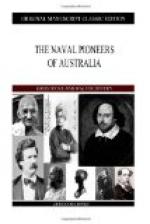From Dr. Hawkesworth’s pedantic volumes to Sir Walter Besant’s delightful sketch, there are any number of versions of the story of Cook’s life and work. Let us assume that everyone knows how James Cook, son of a superior farm labourer in Yorkshire, at thirteen years of age apprenticed to a fishing village shopkeeper, ran away to sea in a Whitby collier, and presently got himself properly apprenticed to her owners, two Quaker brothers named Walker, and how at twenty-seven years of age, when he had become mate of a small merchantman, he determined to anticipate the hot press of May, 1755, and so at Wapping volunteered as A.B. on board His Majesty’s ship Eagle.
His knowledge of navigation and his good conduct led to such recognition that when he was under thirty he was appointed master of the Mercury. His surveying work on the St. Lawrence at the siege of Quebec was so carried out that the Admiralty saw in him one of the most promising officers in the service; and Sir Hugh Palliser, one of the first men to “discover” Cook, was from this time, his best friend, giving him, in 1764, an appointment as marine surveyor of Newfoundland, where Palliser was governor. Cook was then a good seaman and a clever navigator, but there is no doubt his special talents were by this particular service afforded an opportunity for full development, and so he became the best scientific man in the navy. In 1769 it was determined to send an expedition to the Pacific to observe the transit of Venus. Cook had just returned from Newfoundland, and he was appointed to the command.
Seventy years had elapsed since Dampier’s voyage in the Roebuck. Meanwhile what had the English done in the way of South Sea exploration? What was the navy like at this time, a year before Nelson, a youngster of twelve, first went to sea?
There are books enough in print to reply to these questions; but with how much more interest could they be answered if the [Sidenote: 1769] newspaper press, with its interviewers and its photo-reproductions, had been then what it is now. To put life into the skeleton histories, to give us sea life as it was and sailors as they were, we have to trust mostly to the novelists, who, except in rare instances, draw untrustworthy exaggerations.
No doubt there are families who have, so to speak, specialized their traditions for generations; and a naval family’s traditions for the last two centuries would make a most entertaining book. Suppose, for instance, there were living at Portsmouth a man whose family for generations had prided itself on some one of its members having shaken hands with all the great sailors who at some time or other in their careers must have sailed from Spithead. This man could tell us how his father had actually shaken hands with Nelson.




